初中英语拓展知识_巧记时间介词at,in,on的用法
- 格式:wps
- 大小:104.00 KB
- 文档页数:3

一. in,on在方位名词前的区别1. in表示A地在B地范围之内。
如:Taiwan is in the southeast of China.2. on表示A地与B地接壤、毗邻。
如:North Korea is on the east of China.二. at, in, on在表示时间上的区别1. at指时间表示:(1)时间的一点、时刻等。
如:They came home at sunrise (at noon, at midnight, at ten o’clock, at daybreak, at dawn).(2)较短暂的一段时间。
可指某个节日或被认为是一年中标志大事的日子。
如:He went home at Christmas (at New Year, at the Spring Festival, at night).2. in指时间表示:(1)在某个较长的时间(如世纪、朝代、年、月、季节以及泛指的上午、下午或傍晚等)内。
如:in 2004, in March, in spring, in the morning, in the evening, etc(2)在一段时间之后。
一般情况下,用于将来时,谓语动词为瞬间动词,意为“在……以后”。
如:He will arrive in two hours.谓语动词为延续性动词时,in意为“在……以内”。
如:These products will be produced in a month.注意:after用于将来时间也指一段时间之后,但其后的时间是“一点”,而不是“一段”。
如:He will arrive after two o’clock.3. on指时间表示:(1)具体的时日和一个特定的时间,如某日、某节日、星期几等。
如:On Christmas Day(On May 4th), there will be a celebration.(2)在某个特定的早晨、下午或晚上。
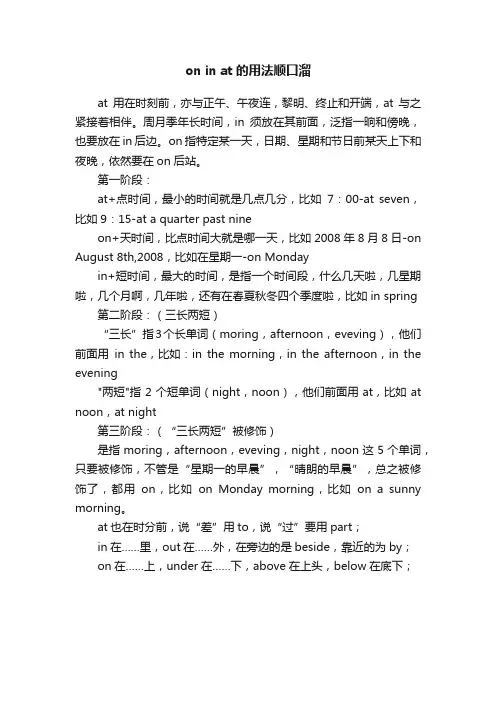
on in at的用法顺口溜
at用在时刻前,亦与正午、午夜连,黎明、终止和开端,at与之紧接着相伴。
周月季年长时间,in须放在其前面,泛指一晌和傍晚,也要放在in后边。
on指特定某一天,日期、星期和节日前某天上下和夜晚,依然要在on后站。
第一阶段:
at+点时间,最小的时间就是几点几分,比如7:00-at seven,比如9:15-at a quarter past nine
on+天时间,比点时间大就是哪一天,比如2008年8月8日-on August 8th,2008,比如在星期一-on Monday
in+短时间,最大的时间,是指一个时间段,什么几天啦,几星期啦,几个月啊,几年啦,还有在春夏秋冬四个季度啦,比如in spring 第二阶段:(三长两短)
“三长”指3个长单词(moring,afternoon,eveving),他们前面用in the,比如:in the morning,in the afternoon,in the evening
"两短"指2个短单词(night,noon),他们前面用at,比如at noon,at night
第三阶段:(“三长两短”被修饰)
是指moring,afternoon,eveving,night,noon这5个单词,只要被修饰,不管是“星期一的早晨”,“晴朗的早晨”,总之被修饰了,都用on,比如on Monday morning,比如on a sunny morning。
at也在时分前,说“差”用to,说“过”要用part;
in在……里,out在……外,在旁边的是beside,靠近的为by;
on在……上,under在……下,above在上头,below在底下;。
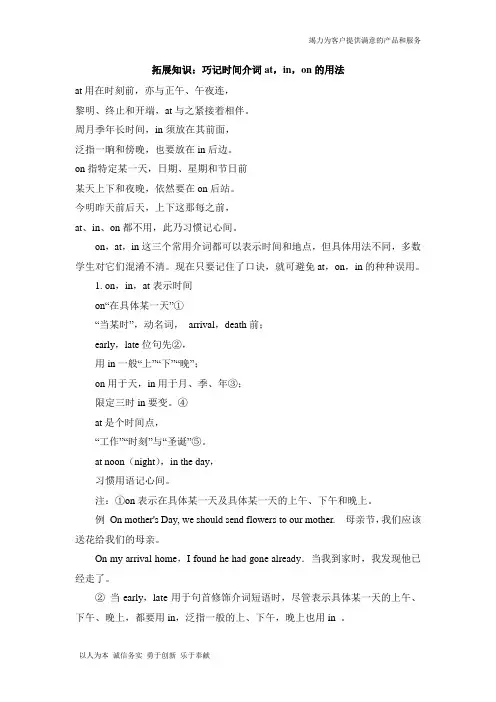
拓展知识:巧记时间介词at,in,on的用法at用在时刻前,亦与正午、午夜连,黎明、终止和开端,at与之紧接着相伴。
周月季年长时间,in须放在其前面,泛指一晌和傍晚,也要放在in后边。
on指特定某一天,日期、星期和节日前某天上下和夜晚,依然要在on后站。
今明昨天前后天,上下这那每之前,at、in、on都不用,此乃习惯记心间。
on,at,in这三个常用介词都可以表示时间和地点,但具体用法不同,多数学生对它们混淆不清。
现在只要记住了口诀,就可避免at,on,in的种种误用。
1. on,in,at表示时间on“在具体某一天”①“当某时”,动名词,arrival,death前;early,late位句先②,用in一般“上”“下”“晚”;on用于天,in用于月、季、年③;限定三时in要变。
④at是个时间点,“工作”“时刻”与“圣诞”⑤。
at noon(night),in the day,习惯用语记心间。
注:①on表示在具体某一天及具体某一天的上午、下午和晚上。
例On mother's Day, we should send flowers to our mother. 母亲节,我们应该送花给我们的母亲。
On my arrival home,I found he had gone already.当我到家时,我发现他已经走了。
②当early,late用于句首修饰介词短语时,尽管表示具体某一天的上午、下午、晚上,都要用in,泛指一般的上、下午,晚上也用in 。
例Early in the morning of National Day,I got up to catch the first bus to the zoo.国庆节一清早,我便起床去赶到动物园的第一班公共汽车。
My father begins work at 8:00 in the morning and stops work at 4:00 in the afternoon.我父亲上午8点上班,下午4点下班。
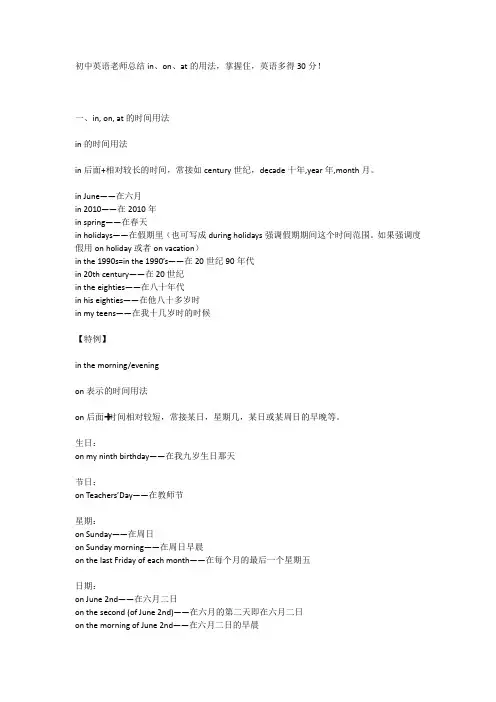
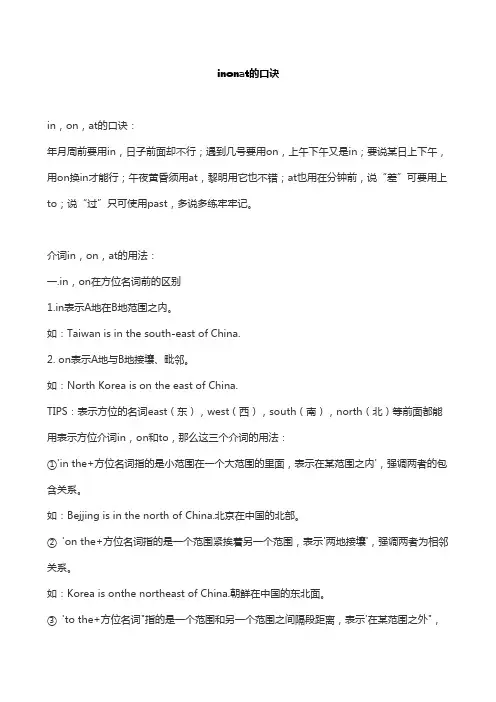
inonat的口诀in,on,at的口诀:年月周前要用in,日子前面却不行;遇到几号要用on,上午下午又是in;要说某日上下午,用on换in才能行;午夜黄昏须用at,黎明用它也不错;at也用在分钟前,说“差”可要用上to;说“过”只可使用past,多说多练牢牢记。
介词in,on,at的用法:一.in,on在方位名词前的区别1.in表示A地在B地范围之内。
如:Taiwan is in the south-east of China.2. on表示A地与B地接壤、毗邻。
如:North Korea is on the east of China.TIPS:表示方位的名词east(东),west(西),south(南),north(北)等前面都能用表示方位介词in,on和to,那么这三个介词的用法:①'in the+方位名词指的是小范围在一个大范围的里面,表示在某范围之内',强调两者的包含关系。
如:Bejjing is in the north of China.北京在中国的北部。
②'on the+方位名词指的是一个范围紧挨着另一个范围,表示'两地接壤',强调两者为相邻关系。
如:Korea is onthe northeast of China.朝鲜在中国的东北面。
③'to the+方位名词"指的是一个范围和另一个范围之间隔段距离,表示'在某范围之外",强调两者是远离关系。
如:Japan is to the east of China.日本位于中国的东边。
二. at,in,on在表示时间上的区别:at表示时间的一点;in表示一个时期;on表示特殊日子。
1. at指时间表示:at后常接几点几分,天明,中午,日出,日落,开始等。
如:at five o' clock(五点),at down(黎明),at daybreak(天亮),at sunrise(日出),at noon(中午),at sunset(日落),at midnight(半夜),at the beginning of the month(月初),at that time(那时),at that moment(那会儿),at this time of day(在一天的这个时候)。
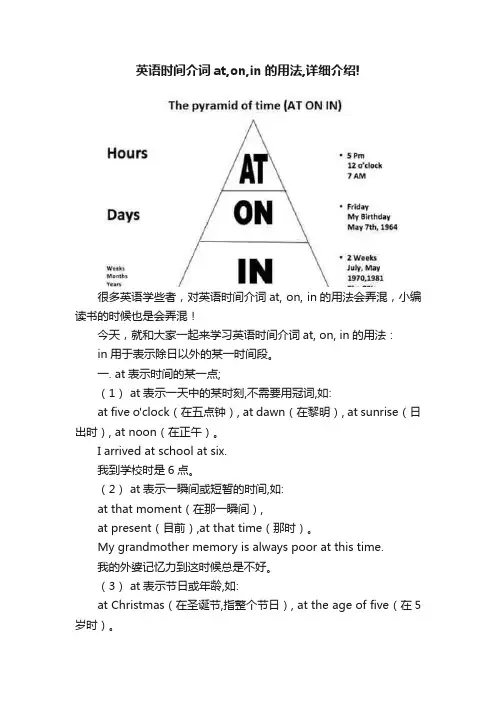
英语时间介词at,on,in的用法,详细介绍!很多英语学些者,对英语时间介词at, on, in的用法会弄混,小编读书的时候也是会弄混!今天,就和大家一起来学习英语时间介词at, on, in的用法:in用于表示除日以外的某一时间段。
一. at表示时间的某一点;(1) at表示一天中的某时刻,不需要用冠词,如:at five o'clock(在五点钟), at dawn(在黎明), at sunrise(日出时), at noon(在正午)。
I arrived at school at six.我到学校时是6点。
(2) at表示一瞬间或短暂的时间,如:at that moment(在那一瞬间),at present(目前),at that time(那时)。
My grandmother memory is always poor at this time.我的外婆记忆力到这时候总是不好。
(3) at表示节日或年龄,如:at Christmas(在圣诞节,指整个节日), at the age of five(在5岁时)。
He'd dropped out of high school at the age of 16他16岁的时候就从中学退学了。
二.on表示某日或和某日连用的某一时间段;on表示某日或和某日连用的某一时间段,如:on Friday(在星期五),on Sunday afternoon(在星期日下午),on the morning of May the eighth(在五月八日早晨), on Christmas Day(在圣诞节,指在当天)。
On Friday evening he passed this word along.星期五晚上他传来了这句话。
三. in用于表示除日以外的某一时间段。
in表示年、月、季节、世纪、时代,与定冠词连用表示一天中某个时间段,如:in 1999(在1999年), in March(在三月), in summer(在夏季), in the 21th century(在二十一世纪), in the eighties(在八十年代), in modern times(在现代), in the morning(在早上)。
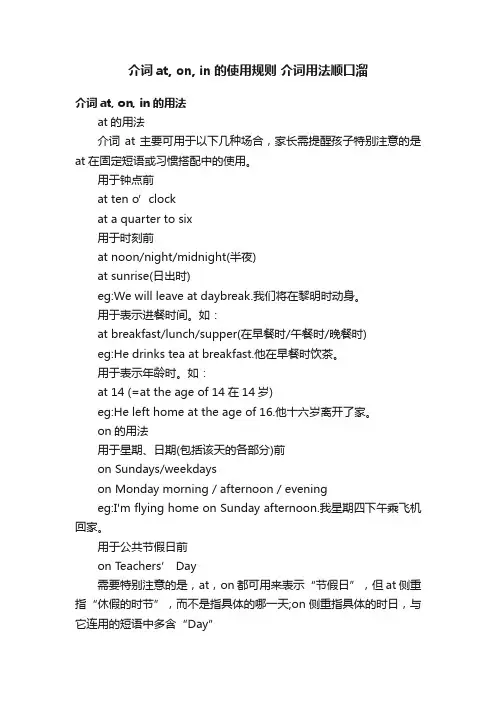
介词at, on, in的使用规则介词用法顺口溜介词at, on, in的用法at的用法介词at主要可用于以下几种场合,家长需提醒孩子特别注意的是at在固定短语或习惯搭配中的使用。
用于钟点前at ten o’clockat a quarter to six用于时刻前at noon/night/midnight(半夜)at sunrise(日出时)eg:We will leave at daybreak.我们将在黎明时动身。
用于表示进餐时间。
如:at breakfast/lunch/supper(在早餐时/午餐时/晚餐时)eg:He drinks tea at breakfast.他在早餐时饮茶。
用于表示年龄时。
如:at 14 (=at the age of 14在14岁)eg:He left home at the age of 16.他十六岁离开了家。
on的用法用于星期、日期(包括该天的各部分)前on Sundays/weekdayson Monday morning / afternoon / eveningeg:I'm flying home on Sunday afternoon.我星期四下午乘飞机回家。
用于公共节假日前on Teachers’ Day需要特别注意的是,at,on都可用来表示“节假日”,但at侧重指“休假的时节”,而不是指具体的哪一天;on侧重指具体的时日,与它连用的短语中多含“Day”in的用法用于泛指一天的上午、下午、傍晚如:in the morning/afternoon/evening/night用于某个较长的时间,像世纪、朝代、年、月、季节in Marchin spring用于表示“从现在起,多久以后或多长时间内”的短语之前She’ll see me again in a week’s time.一周后她再来看我。
I can draw a beautiful horse in five minutes.我可以在五分钟内画好一匹好看的马。
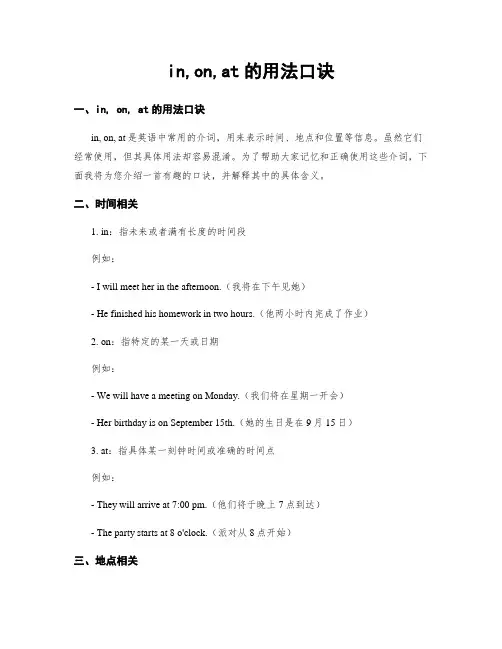
in,on,at的用法口诀一、in, on, at的用法口诀in, on, at是英语中常用的介词,用来表示时间、地点和位置等信息。
虽然它们经常使用,但其具体用法却容易混淆。
为了帮助大家记忆和正确使用这些介词,下面我将为您介绍一首有趣的口诀,并解释其中的具体含义。
二、时间相关1. in:指未来或者满有长度的时间段例如:- I will meet her in the afternoon.(我将在下午见她)- He finished his homework in two hours.(他两小时内完成了作业)2. on:指特定的某一天或日期例如:- We will have a meeting on Monday.(我们将在星期一开会)- Her birthday is on September 15th.(她的生日是在9月15日)3. at:指具体某一刻钟时间或准确的时间点例如:- They will arrive at 7:00 pm.(他们将于晚上7点到达)- The party starts at 8 o'clock.(派对从8点开始)三、地点相关1. in:指大范围区域或封闭空间内部例如:- She lives in California.(她住在加州)- We had dinner in a restaurant last night. (昨晚我们在一家餐馆里吃晚饭)2. on:指在某个平面或具体位置的表面上例如:- There is a book on the table.(桌子上有本书)- The picture hangs on the wall.(这幅画挂在墙上)3. at:指一个特定的地点或场所例如:- Let's meet at the park after school.(放学后我们在公园见面吧)- He works at a hospital.(他在一家医院工作)四、位置相关1. in:指封闭空间内部例如:- The cat is in the box.(猫在盒子里)- She is in her office now.(她现在在办公室)2. on:指物体的表面例如:- The book is on the table. (书在桌子上)- There is a plate on the shelf.(架子上有个盘子)3. at:用于特定的位置或方位例如:- The car is parked at the curb.(车停在路边)- They are standing at the entrance of the building.(他们站在大楼入口处)五、总结使用in, on, at时,需要根据不同的语境和含义进行选择。
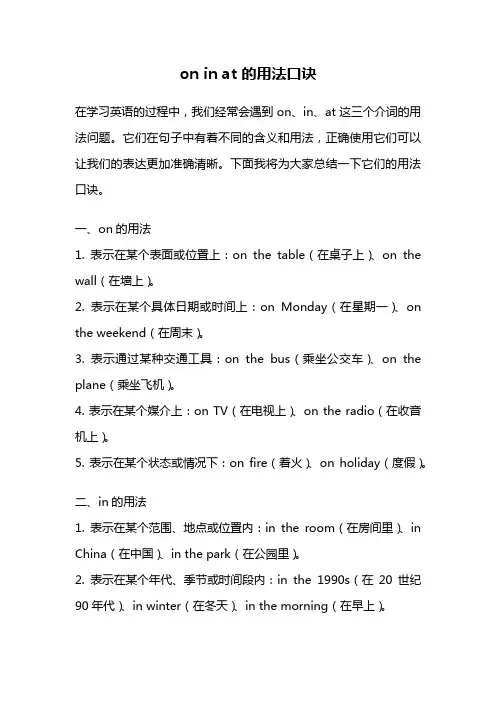
on in at 的用法口诀在学习英语的过程中,我们经常会遇到on、in、at这三个介词的用法问题。
它们在句子中有着不同的含义和用法,正确使用它们可以让我们的表达更加准确清晰。
下面我将为大家总结一下它们的用法口诀。
一、on的用法1. 表示在某个表面或位置上:on the table(在桌子上)、on the wall(在墙上)。
2. 表示在某个具体日期或时间上:on Monday(在星期一)、on the weekend(在周末)。
3. 表示通过某种交通工具:on the bus(乘坐公交车)、on the plane(乘坐飞机)。
4. 表示在某个媒介上:on TV(在电视上)、on the radio(在收音机上)。
5. 表示在某个状态或情况下:on fire(着火)、on holiday(度假)。
二、in的用法1. 表示在某个范围、地点或位置内:in the room(在房间里)、in China(在中国)、in the park(在公园里)。
2. 表示在某个年代、季节或时间段内:in the 1990s(在20世纪90年代)、in winter(在冬天)、in the morning(在早上)。
3. 表示在某个状态或情况下:in trouble(陷入困境)、in love(恋爱中)。
4. 表示在某个媒介或容器中:in a book(在一本书中)、in a bottle(在一个瓶子里)。
5. 表示在某个行为或活动中:in a meeting(在会议中)、in a race (参加比赛)。
三、at的用法1. 表示在某个具体的地点、位置或事件上:at school(在学校)、at home(在家)、at the party(在聚会上)。
2. 表示在某个具体的时间点上:at 3 o'clock(在3点钟)、at noon(在中午)。
3. 表示在某个阶段、状态或情况下:at work(在工作)、at peace (和平)。
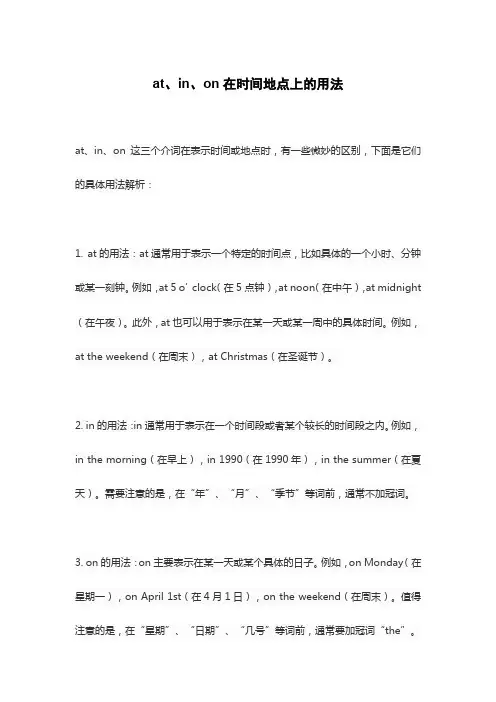
at、in、on在时间地点上的用法at、in、on这三个介词在表示时间或地点时,有一些微妙的区别,下面是它们的具体用法解析:1. at的用法:at通常用于表示一个特定的时间点,比如具体的一个小时、分钟或某一刻钟。
例如,at 5 o’clock(在5点钟),at noon(在中午),at midnight (在午夜)。
此外,at也可以用于表示在某一天或某一周中的具体时间。
例如,at the weekend(在周末),at Christmas(在圣诞节)。
2. in的用法:in通常用于表示在一个时间段或者某个较长的时间段之内。
例如,in the morning(在早上),in 1990(在1990年),in the summer(在夏天)。
需要注意的是,在“年”、“月”、“季节”等词前,通常不加冠词。
3. on的用法:on主要表示在某一天或某个具体的日子。
例如,on Monday(在星期一),on April 1st(在4月1日),on the weekend(在周末)。
值得注意的是,在“星期”、“日期”、“几号”等词前,通常要加冠词“the”。
关于地点方面,这三个介词的区别主要如下:1. at表示在某一点,或者在小的、具体的范围内。
例如,at the bus stop(在公交车站),at the crossroads(在十字路口)。
2. in表示在一个较大的、封闭的空间或者范围之内。
例如,in the classroom (在教室里),in the office building(在办公楼里)。
3. on表示在某个物体的表面或者上方。
例如,on the table(在桌子上),on the floor(在地上)。
以上是at、in、on三个介词的基本用法解析,它们的具体用法可能会因语境的不同而有所变化。
在使用时,要根据具体的语境选择合适的介词。
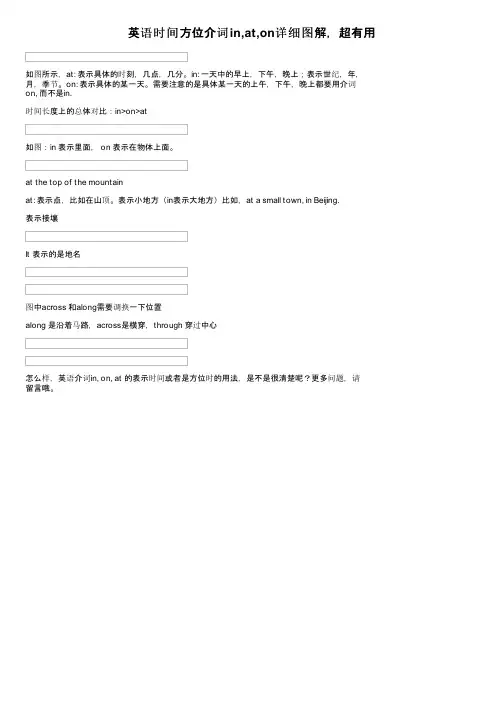
英语时间方位介词in,at,on详细图解,超有用如图所示,at: 表示具体的时刻,几点,几分。
in: 一天中的早上,下午,晚上;表示世纪,年,月,季节。
on: 表示具体的某一天。
需要注意的是具体某一天的上午,下午,晚上都要用介词on, 而不是in.
时间长度上的总体对比:in>on>at
如图:in 表示里面, on 表示在物体上面。
at the top of the mountain
at: 表示点,比如在山顶。
表示小地方(in表示大地方)比如,at a small town, in Beijing.
表示接壤
It 表示的是地名
图中across 和along需要调换一下位置
along 是沿着马路,across是横穿,through 穿过中心
怎么样,英语介词in, on, at 的表示时间或者是方位时的用法,是不是很清楚呢?更多问题,请
留言哦。
in,at,on的用法口诀in, at, on的用法口诀一、引言英语中的介词在句子中起到连接作用,帮助我们描述时间、地点、方式等概念。
其中,in, at, on是最常用且容易混淆的三个介词。
正确运用这三个介词特别重要,因为它们能够直接影响句子的语法和意义。
二、in的用法1. 表示年份、季节或月份时,使用in。
例如:- I was born in 1990. (我出生于1990年。
)- We like to go swimming in summer.(我们喜欢夏天去游泳。
)- She will have a vacation in December.(她将在十二月度假。
)2.表达一个较大的时间段时,同样使用in。
例如:- I will finish this project in two weeks.(我会在两周内完成这个项目。
)- They plan to get married in the spring.(他们计划在春天结婚。
)3.当我们要描述某物或某人位于某个空间范围内时,也要使用in。
例如:- The book is in the bag.(书在袋子里面。
)- He lives in London.(他住在伦敦。
)4.in还可以表示“在……之内”、“经过”等含义。
例如:- She is waiting for us in the cafe.(她在咖啡馆等我们。
)- Please stay in line.(请排队。
)三、at的用法1.表示具体的时间点时,使用at。
例如:- The meeting starts at 9 o'clock.(会议于9点开始。
)- Let's meet at the park gate.(我们在公园门口见面吧。
)2.当我们描述某物或某人所在的地点时,通常使用at。
例如:- I saw him waiting at the bus stop.(我看见他在公交车站等候。
浅谈初中英语中介词“at”“on”“in”的用法在初中英语中,介词是非常重要的一部分,而其中比较常见的介词有“at”、“on”、“in”三个。
虽然它们看起来很简单,但是它们的使用却往往会给初学者带来困惑。
在本文中,我们将会对这三个介词的用法进行详细的解释和分析。
一、“at”“at”这个介词通常用来表示某个具体的时间、地点或事件。
下面是一些常见的用法:1. 表示具体时间:at seven o'clock(在七点钟)、at midnight(在午夜)、at noon (在中午)、at dawn(在黎明时刻)等等。
3. 表示某个具体事件或活动:at the party(在聚会上)、at the concert(在音乐会上)、at the meeting(在会议上)等等。
二、“on”1. 表示具体日期:on April 1st(在4月1日)、on Christmas Day(在圣诞节)等等。
2. 表示具体星期:on Monday(在星期一)、on Friday(在星期五)等等。
3. 表示某个节日:on Halloween(在万圣节)、on Valentine's Day(在情人节)等等。
2. 表示某个季节:in winter(在冬天)、in spring(在春天)等等。
需要注意的是,在某些情况下,这三个介词的用法是可以交替使用的。
例如:2. in the afternoon / at noon(在中午)3. in May / on May 1st(在5月 / 在5月1日)因此,在实际运用中,我们需要根据具体的语境和含义来选择合适的介词。
总之,了解这些介词的用法对于掌握初中英语非常重要。
通过不断的练习和运用,相信大家都能够熟练掌握它们的用法,进而提升自己的英语水平。
介词at,in与on的用法与区别介词 at,in 与 on 的用法与区别介词在英语中起着重要的作用,它们能够帮助我们更准确地表达时间、地点和其他相关的概念。
在众多介词中,at、in 和 on 是使用频率较高的三个,但其用法和区别常常让学习者感到困惑。
接下来,让我们详细探讨一下它们的具体用法和区别。
一、at 的用法1、表示具体的时间点“at”通常用于表示具体的时间点,例如:at six o'clock(在六点钟)、at noon(在中午)、at midnight(在午夜)。
2、表示特定的时刻或短暂的瞬间at the moment(此刻)、at that time(那时)、at the beginning/end (在开始/结束时)。
3、表示某个具体的场所或地点at the bus stop(在公交车站)、at the airport(在机场)、at the door (在门口)。
二、in 的用法1、表示较长的时间段in the morning/afternoon/evening(在上午/下午/晚上)、in May(在五月)、in 2023(在 2023 年)、in summer/winter(在夏天/冬天)。
2、表示在某个较大的空间或范围之内in the city(在城市里)、in the country(在乡村)、in the room(在房间里)。
三、on 的用法1、表示具体的日期on Monday(在星期一)、on May 1st(在五月一日)、on Christmas Day(在圣诞节)。
2、表示在某一天或某一天的上午、下午、晚上on Sunday morning(在星期天上午)、on the evening of June 1st (在六月一日的晚上)。
3、表示在某个表面上on the table(在桌子上)、on the wall(在墙上)。
四、at,in 与 on 在时间表达上的区别1、时间点用“at”例如:“at 7:30”(在七点半),“at dawn”(在黎明)。
一、in的用法法1、in 表示位置“在……里面”例如: My schoolbag is in the classroom.我的书包在教室里。
2、表示时间(1)、表示一天的某一部分时间/某个时间段例如: in the morning 在早上in the afternoon 在下午in the evening 在晚上,在傍晚in the night 在夜里(强调在夜里的某段时间段时间,at night 在夜里/间,指整个夜里;指在夜里时可互换)(2)、in + 世纪/年代(in后要加the) 表示在…世纪/年代例如: My grandmother was born in the 19th century.我的奶奶出生在19世纪。
My uncle came back to Beijing in the 1990s.我的叔叔是在上个世纪90年代回北京的。
(3)、in +年份表示在…年例如: My uncle went to Shanghai in 1996.我叔叔在1996年去了上海。
(4)、in + 月份表示在…月例如: We plant trees in March every year.我们在每年的三月份种树。
(5)、in + 季节表示在某个季节例如: In Hainan , it never snowed in winter.在海南,冬天从来没有下过雪。
3、in + 一段时间表示多久之后(一般用于将来时态)例如:I will be back from Beijing in two days.我两天后从北京回来。
(表示从现在起多久以后)4、in + 语言表示用…语言或用…语言说/写例如:What's this in English? 这个用英语怎么说?He is writing a letter to his father in Chinese.他正在用中文给他父亲写信。
Can you say it in English? 你能用英语说吗?5、in + 颜色/衣服表示穿什么(颜色)的衣服例如: The girl in red is my sister.那位穿红色衣服的女孩是我的妹妹。
atonin的⽤法及区别表⽰时间的某⼀点、某⼀时刻或年龄等⽤at;泛指⼀般意义的上午、下午或晚上以及⽉或年等较长的时间,⼀般⽤in;若表⽰星期⼏或某⼀特定的⽇期,则⽤on等。
in,on在⽅位名词前的区别1.in表⽰A地在B地范围之内。
如:Taiwan is in the southeast of China.2.on表⽰A地与B地接壤、毗邻。
如:North Korea is on the east of China.at,in,,on在表⽰时间上的区别1.at指时间表⽰:(1)时间的⼀点、时刻等。
如:They came home at sunrise (at noon,at midnight,at ten o’clock,at daybreak,at dawn).(2)较短暂的⼀段时间。
可指某个节⽇或被认为是⼀年中标志⼤事的⽇⼦。
如:He went home at Christmas (at New Year,at the Spring Festival,at night).2.in指时间表⽰:(1)在某个较长的时间(如世纪、朝代、年、⽉、季节以及泛指的上午、下午或傍晚等)内。
如:in 2004, in March。
(2)在⼀段时间之后。
⼀般情况下,⽤于将来时,谓语动词为瞬间动词,意为“在……以后”。
如:He will arrive in two hours.谓语动词为延续性动词时,in意为“在……以内”。
如:These products will be produced in a month.注意:after⽤于将来时间也指⼀段时间之后,但其后的时间是“⼀点”,⽽不是“⼀段”。
如:He will arrive after two o’clock.3.on指时间表⽰:(1)具体的时⽇和⼀个特定的时间,如某⽇、某节⽇、星期⼏等。
如:On Christmas Day(On May 4th),there will be a celebration.(2)在某个特定的早晨、下午或晚上。
at、on和in在表示时间上的用法英语中表示时间的时候,经常会用到at、on和in,但是什么时候用哪个词,大家还是要引起注意。
这里我们把这几个词的用法和大家一起总结一下:一、at1、在小到点钟的具体时间,比如:We are going to have meeting at three o'clock.She usually has breakfast at seven.2、在noon,weekend,night,sunrise等词的前面,比如:The policemen still work at noon.We will have a farewell party for Richel at this weekend.3、在节日的前面,表示节日期间,比如:Traditionally, Chinese people will go back home at Spring Festival.Americans always have a lot of fun at Chrismas.二、on1、用于星期几、几号等时间前,比如:I'm to take the flight 2355 on Monday.We have dicided to visit our teacher on 26th May.2、用于特定的时间点,以及weekend,比如:on Christmas Eve/Day三、in1、用在世纪、年份、月份、春夏秋冬、早上、晚上前面,比如:in 2017in Augustin summerin the mornign2、在周一早上,根据就近原则,要用on Monday Morning,或者in the morning of Monday在一个炎热的下午,要用on a hot afternoon。
这些是常见的一些用法,供大家参考。
初中英语拓展知识:巧记时间介词at,in,on 的用法
at 用在时刻前,亦与正午、午夜连,
黎明、终止和开端,at 与之紧接着相伴。
周月季年长时间,in 须放在其前面,
泛指一晌和傍晚,也要放在in 后边。
on 指特定某一天,日期、星期和节日前
某天上下和夜晚,依然要在on 后站。
今明昨天前后天,上下这那每之前,
at、in、on 都不用,此乃习惯记心间。
on,at,in 这三个常用介词都可以表示时间和地点,但具体用法不同,多数
学生对它们混淆不清。
现在只要记住了口诀,就可避免at,on,in 的种种误用。
1. on,in,at 表示时间
on“在具体某一天”①
“当某时”,动名词,arrival,death 前;
early,late 位句先②,
用in 一般“上”“下”“晚”;
on 用于天,in 用于月、季、年③;
限定三时in 要变。
④
at 是个时间点,
“工作”“时刻”与“圣诞”⑤。
at noon(night),in the day,
习惯用语记心间。
注:①on 表示在具体某一天及具体某一天的上午、下午和晚上。
例On mother's Day, we should send flowers to our mother. 母亲节,我们应该送花给我们的母亲。
On my arrival home,I found he had gone already.当我到家时,我发现他已经走了。
②当early,late 用于句首修饰介词短语时,尽管表示具体某一天的上午、
下午、晚上,都要用in,泛指一般的上、下午,晚上也用in 。
例Early in the morning of National Day,I got up to catch the first bus to the zoo.国庆节一清早,我便起床去赶到动物园的第一班公共汽车。
My father begins work at 8:00 in the morning and stops work at 4:00 in the afternoon.我父亲上午8 点上班,下午4 点下班。
③于将来时态表示“过一段时间后”及表示“在……期间”和“在某个季节,
某年、某月”都用in。
例I hear he’ll be back in a month.我听说他将于一个月后回来。
In the course of the last lesson in French,little Franz was listening to the master very attentively.在那最后一堂法语课中,小弗朗兹非常用心地听着老师讲。
Xiao Ming was born in December of 2004. 小明生于2004 年12 月。
④当morning,afternoon,evening 有前位定语或后置定语限定时,就不用in
而用on。
例on a hot (summer) noon 在一个炎热(夏天)的中午
on Monday morning 在星期一上午
on the morning of March 8th 在3 月8 日上午
⑤表示某时某刻及在work,Christmas 前用at。
例We get up at eight o’clock.我们8 点起床。
My father are busily at work all day.我父亲整天忙于工作。
In western countries children get present from their parents at Christmas.在西方国家,孩子们在圣诞节得到父亲给的礼物。
【in】我是“大姐”,因为我后面所接的都是较长时间。
具体用法有:
1.表示在较长的时间里(如周/月份/季节/年份/世纪等)。
如:in a week;
in May;in spring/summer/autumn/winter;in 2008;in the 1990’s等。
2.表示在上午、下午或晚上。
如:in the morning/afternoon/evening。
3.in the daytime(在白天)属于固定搭配,指从日出到日落这一段时间,反义
词组是in the night。
4.“in+一段时间”表示“多久以后/以内”,常与将来时连用。
如:in half an hour;in ten minutes;in a few days 等。
【on】我是“二姐”,我后面所接的时间多与日期有关。
具体用法有:
1.表示在具体的某一天(如日期、生日、节日或星期几)。
如:on May 4th,1919;on Monday;on Teachers’ Day;on my birthday;on that day 等。
2.表示某一天的上午、下午或晚上。
如:on the morning of July 2;on Sunday afternoon;on a cold winter evening 等。
【at】我是“小妹”,因为接在我后面的时间最短。
具体用法有:
1.表示在某一具体时刻,即几点几分。
如:at six o’clock;at half past nine;at a quarter to six;at this time 等。
2.表示在某一短暂的时间。
如:at noon;at this moment;at the end of a year;at the start of the concert 等。